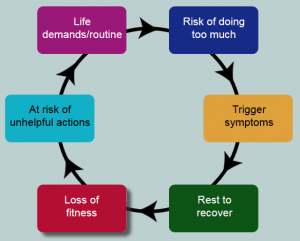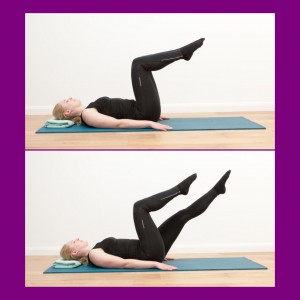How to exercise when affected by a condition causing fatigue
GRADED INCREASE IN ACTIVITY
Try a structured exercise programme that aims to gradually increase the duration and frequency of an activity
First you need to calculate your baseline: how long do you currently complete the activity for? And how often do you complete the activity?
You also need to factor in recovery: how long does it currently take for you to recover from completing the activity?
Using this information a programme can be built with both measurable and achievable goals. This programme can be built for you by a physiotherapist, or a specialist trained in Graded Exercise Therapy.
THREE STEPS TO TRY…
- Choose a goal: pick an activity you enjoy, that you would like to be able to do more of
- Break it down: make your goal into short and long term chunks to make it more achievable
- Keep a diary: this can help you find your baseline and monitor improvements
BOOM & BUST
A common cycle for people with fatigue involves the tendency to push yourself until exhaustion or pain causes you to stop. This pain / exhaustion then causes a prolonged period of rest, as your body recovers from the fatigue. Once your energy levels are restored, and the pain has settled, you get going again, and end up pushing yourself to exhaustion again. This viscous circle is known as the boom and bust cycle. At biological level, every time the body is pushed to its limits, the body is flooded with stress chemicals, due to the activation of the fight or flight system. This causes the body to increase sensitivity to both pain and fatigue.
Every time you over-do an activity, it makes you less likely to try again in the future through fear if suffering more pain or fatigue from it. However, it is not that you can’t or shouldn’t do these activities; you are just doing too much of them too soon.
When you cut back on physical activity, your body starts to become deconditioned: joints become stiffer and muscles get weaker. This has a knock-on effect, causing your body to be less able to cope with physical exertion. This means it can often seem like you are getting worse medically, whereas you are in fact just getting weaker physically.
PACING
This involves balancing periods of activity with periods of rest. Pacing requires you to plan your daily and weekly activities around when you can be active and when you need to rest, so planning your diary at the start of each week can help with managing pacing. If you pace your activities at a level that’s right for you, then you will make steady progress with increasing your activity levels.
PHYSIOTHERAPIST LED PILATES CLASSES
Pilates is a great option of a gentle, low impact, graded form of exercise to participate in when suffering from a condition where you need to pace activity.
I take several classes across Essex:
Mondays 6:30pm & 7:30pm – Grange Community Centre, Rayleigh
Wednesdays 9:30am & 10:30am – Downham Village Hall, Billericay
Thursdays 6pm & 7pm – Orsett Churches Centre, Orsett
Call 07759884594 or email [email protected] to book your FREE trial class!



